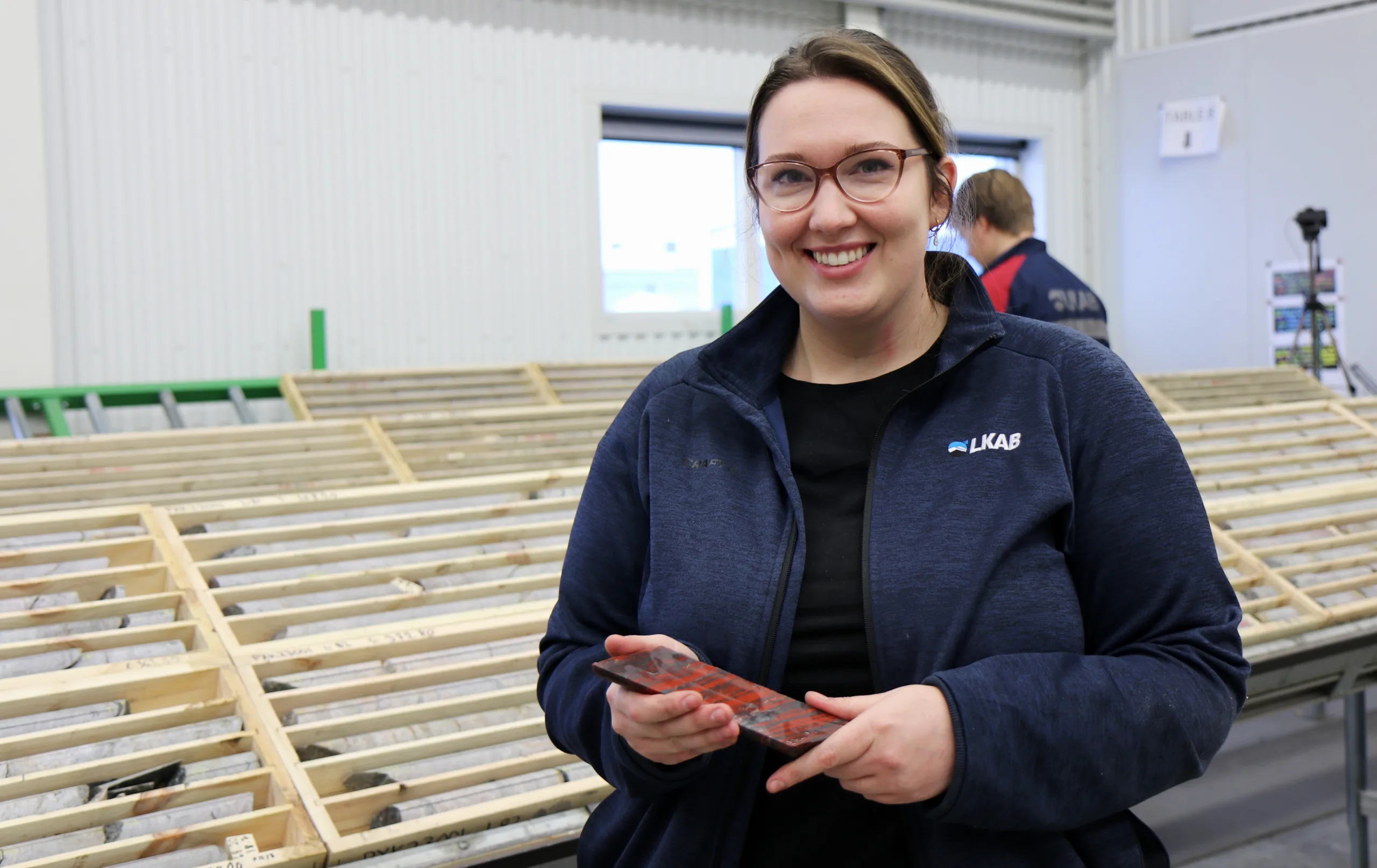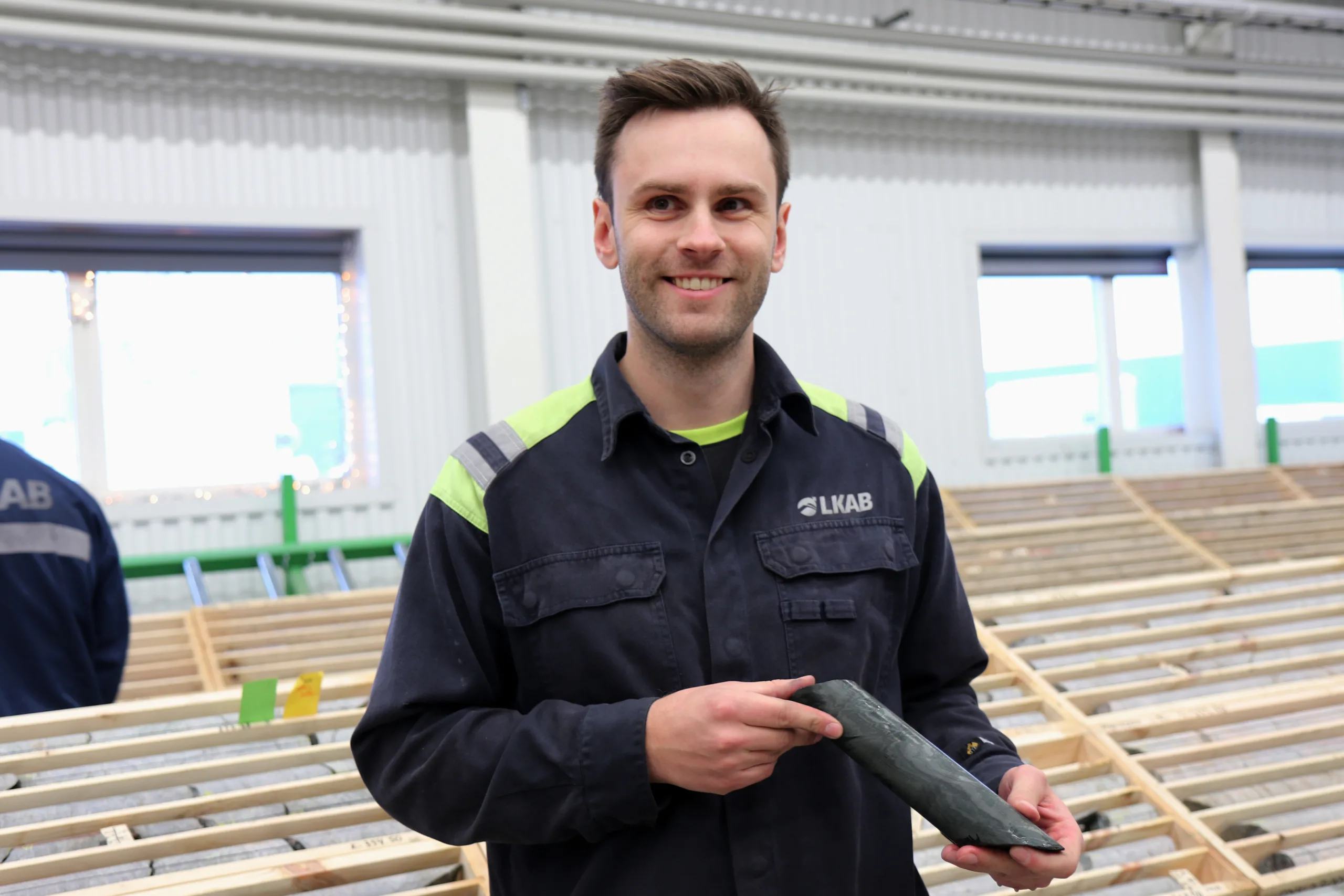Geology – the bedrock of the operation

1.9 billion years. That is the approximate age of the bedrock and our deposits. That makes the bedrock particularly interesting from a geological perspective. It holds many unsolved mysteries, undiscovered treasures and the keys to understanding its history.
“Our work is largely investigative; we have to get to the bottom of the question as to why it looks like it does,” says field geologist Jo Miles, who is studying the Per Geijer deposit.
Quite simply, geology is the study of the origin, constitution and changes in the Earth’s crust, the bedrock, rock types and soil types. Normally, in the science of geology, it doesn’t suffice to just consider the origins of the Earth’s crust in terms of millennia, but rather millions of years. However, in the case of Scandinavia, geologists talk in terms of billions of years. But changes can happen quickly, literally from one day to the next, which means that the the playing field is suddenly redrawn. This is happens, above all, in the case of volcanic eruptions, but also with respect to minerals and rock types, when we consider mineral deposits and how they have formed. Then, the numbers have to be followed by more zeros.
“Much of our work has to do with finding out why things are as they are, the underlying reasons and how everything fits together,” says Jo Miles, a field geologist who is investigating the Per Geijer deposit, continuing,”The present is the key to the past when we try to understand the origins and the processes. You could say that we are trying to piece together a puzzle and building an understanding of the deposit.”

Analysis of the bedrock
LKAB holds an exploration permit for the Per Geijer deposit, which means that LKAB has an opportunity to survey the properties of the bedrock. This is always done initially, long before there can be any certainty of a possible mine, to determine how the orebody lies, its conditions and extent, and whether it is mineable. This is done via, among other means, test drilling, whereby the drill core samples enable geologists to gain a successively better understanding of the deposit. Each drill core contains an important piece of information that is decisive for the entire picture. In other words, each core sample is a clue that leads closer to the solution, for understanding both the past and the future.
“Since we are dealing with ancient geology, there are many things about the origin of the deposit that we can never really know for certain. For example, it has to with the position of the Earth’s tectonic plates from the beginning, and they are no longer there for us to study,” explains Jo Miles.
Quite simply, studying the properties of the bedrock involves mapping and determining the extent and distribution of rock types, the mineralogical composition, age and possible structures. In some way, it is the first chapter of a new story about Per Geijer, about old processes and events. And as with all memorable stories, it offers excitement, drama and plot twists.
“When we study an orebody, we often find the answers in the surrounding rock mass. Reddish stone, for example, gives an indication that we are approaching the ore,” says Johan Hilmo, field geologist and a member of the exploration team for Per Geijer.
When it comes to geology, there is seldom a single answer and a simple explanation as to why things are as they are. Discoveries often have to be mulled over, considered and reconsidered and, not least, felt and experienced.
“It’s a continuous learning process, and we need a team of geologists to discuss the appearance and composition of the drill cores,” says Johan Hilmo.
Analysis of drill core samples
Being a geologist is not just about using inherited knowledge and tools. It also involves the senses; sight, hearing and touch. How a core sample feels at the touch of a magnetic pen (a sort of telescopic magnetic tool), or how the colouration looks; these factors have significance for the data that are subsequently entered into the system.
“I have more faith in my colleagues’ assessments, experience and knowledge than in any system that can make estimations,” says Laura Lauri, section manager for the field exploration team. That is why a lot of discussion and dialogue among colleagues is necessary; to assure the quality of the information when core samples are studied. In a geology context, this type of study is called geological mapping, which is done according to a set procedure. Each core sample undergoes the same type of basic visual inspection.
“We use a few tools; a magnifying glass, different types of hard scrapers and water,” says Jo Miles.
Water brings out the colours, making it easier to study the core sample. However, this isn’t true in the case of iron ore, specifically magnetite ore, which is very dark and turns black when water is applied.
“Core samples are sent to two different laboratories, were they are crushed, so the material can be studied in even greater detail. The laboratory results give us a very accurate and reliable body of data,” says Jo Miles.


A deposit is born
What drives an exploration geologist has little to do with how a deposit can be mined and subsequently processed into products. Instead, the motivating factor is the desire to understand the origin, how everything fits together and why things are as they are. In other words, solving the mystery – just like a detective.
“We began work in 2020 and have since drilled about 100 holes. This entails some 100 kilometres of drill cores and we’re building an understanding of the geology,” says Laura, continuing, “Working from the ground up, we can see that we have similar mineralisations in Svappavaara and Malmberget, with similar rock types.
But this area is different, since the Per Geijer deposit formed in a volcano-sedimentary environment, which means that the rock types have formed via extension, sedimentation and compression. Consequently, this makes Per Geijer a very complex deposit that has undergone a long process – a process that has taken place over the millennia as the tectonic plates have shifted.
“Each new drill hole reveals new truths and, together, we are seeing things that nobody has seen before. That’s exciting,” says Laura Lauri, continuing, “Therefore, our various experiences, as geologists, are important when we discuss the deposit. My team represents six different nationalities and, collectively, we share a broad range of different strengths and knowledge.”
Johan Hilmo and Jo Miles concur, emphasising the need for diversity in such a group. “Input from five or more individuals is much more valuable than a single person’s assessment,” says Jo Miles.
After just over three years, the exploration work has come a long way, but the mystery has not been completely solved. Much work remains to be done, but the team has begun to reach the outer edges of the deposit, which means they have a clearer understanding of its extent.
“In exploration, every drill metre is significant and when you start this type of work, you start big and work your way down to the details,” explains Laura Lauri.
This means that the initial drill holes are placed relatively far apart from one another, and then in a successively denser pattern.
“We plan to drill 40–50 kilometres next year,” adds Laura Lauri.

Magnetite and hematite
Iron ore mined in conventional mines normally occurs in two forms, hematite and magnetite. In many cases the orebody hosts both minerals, which is the case in all of LKAB’s mines. But to further complicate the matter, there are mixed mineralisations that contain both hematite and magnetite in LKAB’s mines and deposits.
“Per Geijer contains both hematite and magnetite. The hematite occurs mainly near the surface, while the magnetite is deeper down in the mineralisation,” says Jo Miles.
The appearance and quality of the deposit provide the basis for determining how the ore is to be subsequently mined, via either underground or open-pit mining. The major difference between magnetite and hematite is that magnetite, unlike hematite, is magnetic. In addition, hematite tends to occur near the surface, which is in some cases due to the fact that the magnetite has been exposed to the effects of oxygen and running water during the formation process. Sometimes, magnetite transforms into hematite, which is probably the case with Per Geijer.
“Hematite is often reddish. When we encounter more reddish core samples, this is often an indication that we are approaching the magnetite ore,” says Johan Hilmo.
Unlike the Kiruna mine, which consists largely of pure magnetite, the composition of Per Geijer is much more complex. However, Per Geijer, just as the other deposits mined by LKAB, is a so-called apatite iron ore. This means that the ore has high phosphorus content; in the case of Per Geijer, a very high content.
“Apatite occurs in different forms in Per Geijer, in both hematite and magnetite. For example, apatite can occur as veins in the rock and often has a pink or light-grey tone,” explains Johan Hilmo.
As mentioned earlier, things are seldom obvious or self evident when it comes to geology. Undoubtedly, the famous words of Socrates, “the more I learn, the less I realise I know”, could never be more relevant than in the context of the science of geology. The learning process and the continuous acquisition of knowledge are vital for improving our understanding. This is exemplified by the occurrence of apatite in Per Geijer; how apatite presents itself and how the exploration team is becoming successively better at mapping it.
“Among other instruments, we use a so-called XRF scanner to detect apatite. We also use special lamps, since apatite shines in the dark. Over the years, we have learned much about the origin and appearance of the apatite,” adds Johan Hilmo.

Rock-solid foundation
The Kiruna mine and the so-called Kiruna ore are well known in the field of geology. Above all, this is due to the size of the orebody, the exceptionally high iron content, the occurrence of apatite and the fact that its geological history is still keenly debated.
“Although Per Geijer’s hanging wall – the rock above the orebody– is unique, it shares many similarities in terms of the rock types in Svappavaara,” says Johan Hilmo.
This, on the other hand, is an indication that the two deposits are closely related and somehow linked. However, both the ore and the barren rock differ from that of the Kiruna mine.
“We know far from everything about Per Geijer. There is still a lot left to explore,” says Jo Miles.
Although the two deposits, Per Geijer and the Kiruna ore, formed at roughly the same time and lie close to each other, they have most probably formed in different ways.
“Regardless of whether the processes differ, there are indications that the rock types of the orefields have formed through closely related processes and that, in some way, they fit together. There is reason to assume that Per Geijer and the Kiruna ore may be linked,” concludes Jo Miles.
Text and photo: Josefine Ejemalm




